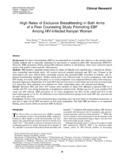| dc.contributor.author | Bosire, Rose | |
| dc.contributor.author | Betz, Bourke | |
| dc.contributor.author | Aluisio, Adam | |
| dc.contributor.author | Hughes, James P | |
| dc.contributor.author | Nduati, Ruth | |
| dc.contributor.author | Kiarie, James N | |
| dc.contributor.author | Chohan, Bhavna H | |
| dc.contributor.author | Merkel, Michele | |
| dc.contributor.author | Lohman-Payne, Barbara | |
| dc.contributor.author | John-Stewart, Grace | |
| dc.contributor.author | Farquhar, Carey | |
| dc.date.accessioned | 2016-05-26T14:50:58Z | |
| dc.date.available | 2016-05-26T14:50:58Z | |
| dc.date.issued | 2016 | |
| dc.identifier.citation | Breastfeeding Medicine. March 2016, 11(2): 56-63. | en_US |
| dc.identifier.uri | http://online.liebertpub.com/doi/abs/10.1089/bfm.2015.0071 | |
| dc.identifier.uri | http://hdl.handle.net/11295/95958 | |
| dc.description.abstract | Background: Exclusive breastfeeding (EBF) is recommended for 6 months after delivery as the optimal infant feeding method and is especially important for prevention of mother-to-child HIV transmission (PMTCT). However, EBF promotion efforts among HIV-infected mothers in sub-Saharan Africa have achieved mixed success and require context-specific interventions.
Methods: HIV-positive, pregnant women from six clinics in Nairobi were enrolled into a clinic-level, before–after counseling intervention study. All women received standard perinatal and HIV care. Women in the intervention arm were offered three counseling sessions that promoted EBF, described its benefits, and explained breastfeeding techniques. Mother–infant pairs were followed until 14 weeks postpartum, with infant HIV testing at 6 weeks. EBF prevalence at 14 weeks postpartum was compared between study arms using log-binomial regression. Proportions of 6-week HIV-free survival and 14-week infant survival were assessed using Cox regression. Risk estimates were adjusted for clinic, relationship status, and antiretroviral therapy.
Results: Between 2009 and 2013, 833 women were enrolled of whom 94% planned to practice EBF for 6 months and 95% were taking therapeutic or prophylactic antiretrovirals. Median age was 27 years; median CD4 count was 403 cells/μL. EBF prevalence at 14 weeks postpartum was 86% in the control and 81% in the intervention group (p = 0.19). No differences were observed between groups for 6-week HIV-free survival and 14-week infant survival.
Conclusion: Women who received breastfeeding counseling were not more likely to breastfeed exclusively, in part due to high overall EBF prevalence in this study population. The high EBF prevalence is an important finding, given recent efforts to promote EBF in Kenya. | en_US |
| dc.language.iso | en | en_US |
| dc.rights | Attribution-NonCommercial-NoDerivs 3.0 United States | * |
| dc.rights.uri | http://creativecommons.org/licenses/by-nc-nd/3.0/us/ | * |
| dc.title | High Rates of Exclusive Breastfeeding in Both Arms of a Peer Counseling Study Promoting EBF Among HIV-Infected Kenyan Women | en_US |
| dc.type | Article | en_US |



